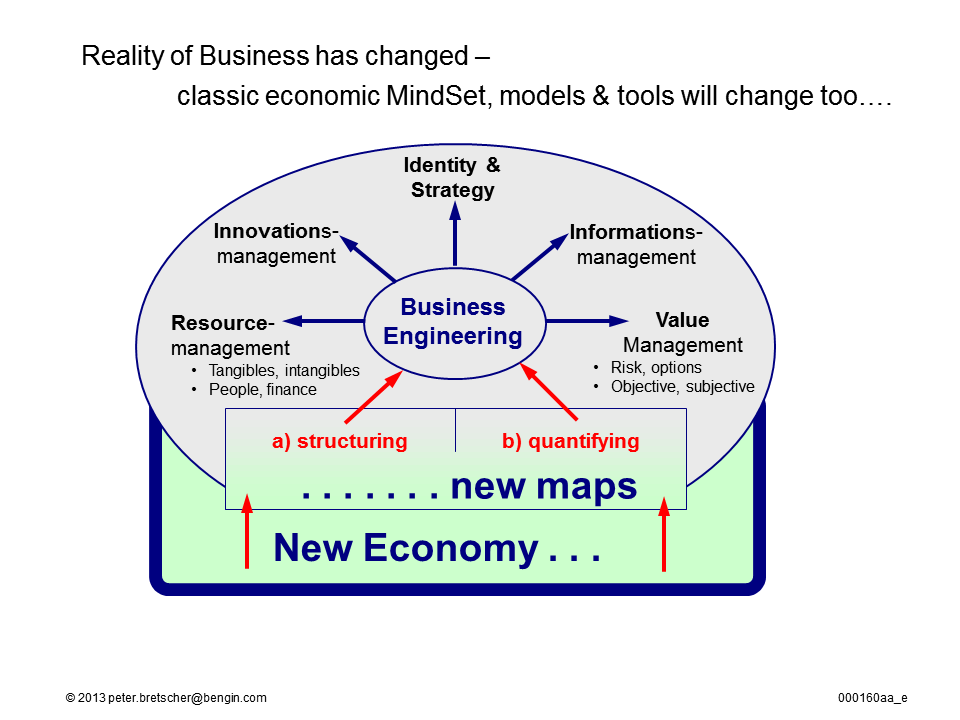
Intangibles as Assets
Originally shared by Peter Bretscher
For better performance. Look at Intangibles as Assets.
Positive Perspektiven für Wirtschaft, Politik und Gesellschaft
Intangibles as Assets

Intangibles as Assets
Originally shared by Peter Bretscher
For better performance. Look at Intangibles as Assets.
Mapping the power of potential

Originally shared by Peter Bretscher
Mapping the power of potential
Same category: Where’s the Beef for: Controlling, Audit, enterprise valuation, marketing….?
Same category: Where’s the Beef for: Controlling, Audit, enterprise valuation, marketing….?
Originally shared by Peter Bretscher
Where’s the Beef for Business Intelligence?
Here it is. Combining Economic AND Social Value.
Outperforms linear mindsetting and short term monetary tageting.
Better solution for planning enterprises and nations…
Only disadvantage: Needs some brain.
1st step to the Original Business Engineering

1st step to the Original Business Engineering
Originally shared by Peter Bretscher
Good news – SAP – Financial and Non-Financial Performance 2012 – Integrated Reporting.
http://www.sapintegratedreport.com/2012/en/
An important step to the next (Vector Based, Hybrid) Value Reporting System.
See 1st paper of Juergen Daum (SAP) and me 2004, links for pdf & ppt:
http://www.bengin.net/pmappt_e2.htm
Measuring Performance in a Knowledge Economy: Linking the Subjective and Objective Value Measurement into a „Vector-Based“ Concept for Performance Measurement.
Das gehört zum richtigen Business Engineering.

Das gehört zum richtigen Business Engineering.
Originally shared by Peter Bretscher
Spannende neue Argumente und Dimensionen für Marketinger, Strategen…
Monetäre (aus Rechnungswesen…) und nicht-monetäre (subjektive, zum Beispiel von Kunden) Werte von verschiedenen Produkten (Marken, Business Units, Firmen….) korrelieren und deren Bedeutung im Gesamtkontext erkennen.
Wir haben dafür in den letzten 10 Jahren einige interessante Tools entwickelt.
Business Engineering ist die Gestaltung und Entwicklung von intelligenten Unternehmen und deren Geschäftsbeziehungen.
Weil die Produktionsfaktoren (Boden, Arbeit, Kapital) der klassischen Wirtschaftslehre (Business Administration) die Realität der intelligenten Wirtschaft nicht (mehr) genügend erfassen/abbilden, baut Business Engineering auf den materiellen (physische Produkte….) und immateriellen (Wissen, Können, Erfahrung, Geistiges Eigentum…) Ressourcen auf.
Zudem wird im quantitativen Teil das klassische monetäre Werteparadigma so erweitert, dass auch nicht-monetäre und subjektive Werteindikatoren integriert sind.
Business Engineering führt in logischer Folge zu einer bisher unerreichten Transparenz im Verständnis von Wertschöpfungsoptionen und neuen Freiheiten für ein nachhaltiges Wachstum in Wirtschaft, Politik und Gesellschaft.
Dokumentiert ist diese Sichtweise mit den neuen unternehmerischen Perspektiven in den „Business Engineering Systemen“.

Business Engineering hat auf Google+ eine offene Community:
https://plus.google.com/communities/110058326650247176573
Schauen Sie rein, lassen Sie sich inspirieren. Bringen Sie Ihre Meinung und Lösung ein.
Für’s Mitdiskutieren ist eine Anmeldung erforderlich.
He is rights. And we are a step ahead. We have the next Gen metrics solution.
Documented in the „Business Engineering Systems“.
The metric system for economic valuation had to be reinvented.
New system is already here. And it’s vector based. That allows to combine even monetary with non-monetary value indicators.
Gives tons of new insights, business options, transparency in (business) valuation….
for a more sustainable development.
Read Bill’s letter about the importance and contact us for the better solution.
Why do I care so much about measurement? It’s not as odd as it seems. Watch my video: b-gat.es/UBMJvU
— Bill Gates (@BillGates) 31. Januar 2013
Business Engineering = Localize Intangible Assets, choose strategy for additional offerings…

Business Engineering = Localize Intangible Assets, choose strategy for additional offerings…
….earnings beyond classic Business Administration „maps“ and mindset.
More on structuring an quantifying is comming – stay tuned

More on structuring an quantifying is comming – stay tuned
Originally shared by Business Engineering
Business Engineering is based on broader framework for structuring and quantifying economic’s reality.
It has a positive impact on most of classic economic mindset – bridges the gap between strategy and operations – and enables more integrated decision making and new business options.
Business Engineering is based on broader framework for structuring and quantifying economic’s reality.

Business Engineering is based on broader framework for structuring and quantifying economic’s reality.
It has a positive impact on most of classic economic mindset – bridges the gap between strategy and operations – and enables more integrated decision making and new business options.